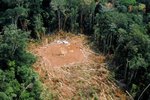
Burrowing owls are considered endangered in Canada and threatened in Mexico. They are also considered endangered, threatened or of special concern in nine U.S. states. Unlike other owls, burrowing owls are not strictly nocturnal, being as active during the day as they are at night. They make their nests in underground burrows, which are dug by prairie dogs or ground squirrels, and prefer open grasslands. Several factors are responsible for their rapidly declining numbers.
Human Encroachment
Human encroachment has played a significant role in the declining numbers of burrowing owls. As grasslands are cleared to make way for roads, houses and farms, burrowing owls lose much of their natural habitat. Areas once populated with very few humans are suddenly packed with them, leaving the owls in very close proximity to heavily trafficked roads and highways and vulnerable to getting hit by vehicles.
Pesticides
Burrowing owls who find themselves sharing their habitat with farmers also suffer because of the pesticides farmers use to keep pests in check. Pests include grasshoppers, which burrowing owls consume. If they consume too many grasshoppers exposed to pesticides, the owls are poisoned as well. Pests also include prairie dogs, ground squirrels and badgers, on whom burrowing owls rely to dig the burrows in which they build their nests. As these rodents are eradicated the owls are left without homes, too, since they are incapable of digging their own burrows.
The Circle of Life
Burrowing owls also have to contend with natural predators, including hawks, horned owls and foxes. Domestic pets are also a danger, particularly to their eggs and younger owls. Although the owls sometimes depend on badgers to dig their burrows, they are occasionally killed and eaten by them -- sometimes because they're mistaken for ground squirrels, in whose burrows they also reside.
Climate Change
Climate change has also played a part in the dwindling number of burrowing owls. Heavy rainstorms flood burrows in Canada, while droughts increase the chances of fires in the western United States. Moreover, grassland habitats are drying out because of warmer temperatures, rendering them uninhabitable for burrowing owls as well as other birds that typically inhabit those areas.
References
- Defenders of Wildlife: Fact Sheet: Burrowing Owl: Threats to Burrowing Owls
- Defenders of Wildlife: Fact Sheet: Burrowing Owl: Basic Facts About Burrowing Owls
- U.S. Fish & Wildlife Service: Status Assessment and Conservation Plan for the Western Burrowing Owl in the United States: Biological Technical Publication, p. 4
- Nature Canada: Endangered Species: Species Spotlight: Burrowing Owl
- Wildlife Preservation Canada: Burrowing Owl
- Center for Biological Diversity: Saving the Western Burrowing Owl
Photo Credits
-
Jupiterimages/Photos.com/Getty Images
Writer Bio
Vivian Gomez contributes to Retailing Today, the Daily Puppy, Paw Nation and other websites. She's covered the New York Comic Con for NonProductive since 2009 and writes about everything from responsible pet ownership to comic books to the manner in which smart phones are changing the way people shop. Gomez received her Bachelor of Arts in English literature from Pace University.




